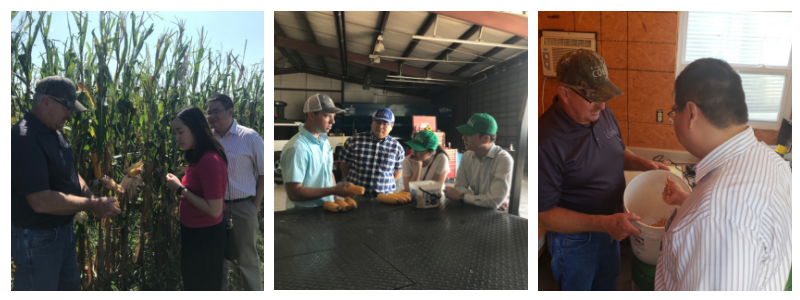Indonesian Trade Team Visits Kansas
Trade Team Matches Indonesian Starch Demand With Confidence In U.S. Corn
Summary from Stacy Mayo-Martinez, Director of Industry Relations and Ken McCauley, Kansas Corn Growers Association President
Indonesian corn buyers were hosted by Kansas Corn recently. The trade team visited progressive farms in eastern Kansas. The group was hosted by Hayden Guetterman, Guetterman Brothers Farms in Bucyrus and Ken McCauley, K&M Farms in White Cloud.

“We enjoyed hosting the Indonesian corn buyers and showing them how we grow corn in Kansas. The value of them seeing the crop, taking a look at our storage facilities and then seeing the picture of where the corn goes once it leaves the farm is very valuable,” McCauley said. “We always enjoy hosting international buyers as it helps them understand the hard work that goes into the product they are buying and using in their countries. Our ability to grow a consistently, high-quality crop to export when you bring all of the U.S. corn together is one of our global competitive advantages.”
In addition, the group was able to see grain being loaded directly into containers to better understand the steps grain goes through and how it is inspected. The group also hopped across the border to Missouri to visit LifeLine Foods. This unique facility uses both dry milling and wet milling techniques to create a multitude of corn values added products. The Indonesians found the processes similar to what they are used to, but the biggest difference involves technology vs. man power. They were very interested in seeing the value placed on the consistent, quality corn supplied to the plant from farms in NE Kansas and NW Missouri.
Official News Release from U.S. Grains Council
Confidence in the U.S. grain supply system helps the U.S. Grains Council (USGC) build market share. And few activities demonstrate the capabilities of the United States as an exporter better than a trade team, as senior leadership from the Indonesia starch industry learned in late August in Kansas and New Orleans.
Prior to the team’s arrival, 73,500 metric tons (2.87 million bushels) of U.S. corn was sold to Indonesia, further underscoring the importance of this industry to corn purchases.
The trade team, organized in collaboration with the Kansas Corn Commission, assessed the capabilities of the U.S. corn export system through visits to grain inspection offices, corn export facilities, corn farms, corn wet milling plants, river terminals and container loading facilities.
“The group was impressed with the size and scale of U.S. operations in addition to the care and attention to quality U.S. farmers have for their corn,” said Caleb Wurth, USGC assistant director of Southeast Asia.
The team visit included firsthand experience with the quality, testing and handling of grain at the last point of contact before departing U.S. shores. Team members were able to board a vessel being loaded with U.S. product in New Orleans and witness barges being unloaded into the export elevator.
“It is important for the group to see the care and attention to detail that goes into making sure they, as customers, receive the quantity and grades sold to them,” Wurth said. “We understand the Indonesian corn buyer has options. This mission showed the passion and commitment to quality of U.S. agriculture from the farmer to the export elevator – sought after qualities when choosing a trading partner.”
Indonesia is the fourth most populous country in the world with a rising middle class, resulting in more demand for meat and the feed needed to produce it. While Indonesia does produce corn, domestic supplies suffer from extreme yield variations, and volumes are insufficient to keep pace with the animal feed industry like the poultry sector, which is expanding at nearly 8 percent per year.
“Half of the country’s corn importers currently have plans to expand capacity,” Wurth said. “With competition from imported Chinese starch, the Indonesian corn starch industry is always striving to gain additional efficiencies to remain competitive.”
The team visit stressed the importance of solid and mutually-beneficial trade partnerships. Indonesia imported 620,000 tons (24.4 million bushels) of U.S. corn in the 2016/2017 marketing year, solely for food processing. Of this corn milling demand, U.S. imports achieved only 20 to 30 percent market share.
“Indonesian starch facilities prefer imported corn, and U.S. corn is particularly valued for high milling yield,” Wurth said. “This trade team builds on prior Council missions to assess what the starch industry needs to foster growth and increase demand for U.S. corn.
“It is important we work together to ensure profitability of both the U.S. farmer and the Indonesian starch industry. We can achieve this goal by having an open dialogue to ensure we, as exporters, produce and deliver what our partners want and need.”
